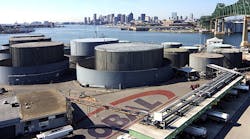In a move that should be welcomed by tank truck fleets, the Pipeline and Hazardous Materials Safety Administration (PHMSA) has ruled that an open vent is not required at the top of a void space on a multi-compartment cargo tank. The final rule took effect immediately on July 20.
This has been a recurring issue for tank truck fleets, especially those running MC306 and DOT406 tank trailers in gasoline service. “This rule is welcome news,” John Conley, president of National Tank Truck Carriers, told Bulk Transporter. There have been a number of conflicting interpretations on this issue over the past several years, but this final rule should put the issue to rest.”
He adds that the immediate rule change “means that if you were to be given a citation today for having plugs in vents on the top of your cargo tank, that violation would no longer be valid. Venting of the void space still is required, but can be accomplished through the drain hole in the void space. You may choose to plug the vent at the top of the void space or to leave it open.”
Here is the specific language for the rule change as it appears in Section 178.345-l(i)(2) that establishes general design and construction requirements for DOT 406 (§ 178.346),DOT 407 (§ 178.347), and DOT 412 (§ 178.348) cargo tank motor vehicles.
Cargo tank motor vehicles composed of more than one cargo tank may be constructed with the individual cargo tanks manufactured to a single specification or to different specifications. Each cargo tank must conform in all respects with the specification for which it is constructed and certified.
The strength of the connecting structure joining multiple cargo tanks in a cargo tank motor vehicle must meet the structural design requirements in § 178.345–3. Any void within the connecting structure must be vented to the atmosphere and have a drain located on the bottom centerline. Each drain must be accessible and must be kept open at all times. The drain in any void within the connecting structure of a carbon steel, self-supporting cargo tank may be either a single drain of at least 1.0 inch diameter, or two or more drains of at least 0.5 inch diameter, 6.0 inches apart, one of which is located on the bottom centerline.
Previous interpretations indicate that a vent must be located as close to the top centerline of the tank as practicable and the drain as close to the bottom centerline of the tank as practicable. Through discussions with industry and enforcement personnel, PHMSA determined that requiring an opening on top of a cargo tank to vent vapors that accumulate in the void space may not be the best practice.
In many instances, such as with gasoline, the vapors are heavier than air and it is not necessary to require cargo tanks to be vented to the atmosphere through a vent located near the top centerline. Vapors heavier than air escape through the drain opening. In addition, venting voids through the top of a cargo tank may cause premature corrosion of the void space as a result of water penetration. Allowing the vent to be plugged will also make it easier to identify when there is actually a leak in the bulkhead. Hazardous materials leaking from the drain will cause an obvious stain/dirt buildup that, with the top vent plugged, cannot be a result of water draining from the top vent and must be a leaking bulkhead.
To address this problem, in the NPRM, PHMSA proposed to revise § 178.345–1 to clearly indicate that any void area within the connecting structure of a cargo tank between double bulk heads must be vented to the atmosphere through the required drain or through a separate vent. The proposed revision will ensure that void spaces in the connecting structure of DOT 406, 407, and 412 cargo tank motor vehicles are properly vented to allow for the escape of product vapors.
This change also promotes the longevity of the tanks by clarifying that it is not necessary to place a vent in the top of a void space where rain water can easily infiltrate the void space and cause corrosion if the product vapors are heavier than air and will vent through the drain. This clarification ensures that the vent is located in the most appropriate location for the material being transported. However, we urge manufacturers to continue allowing for access to the void space through the top of the tank. In addition, we suggest the continued placement of inspection openings of sufficient size and number to permit proper visual internal inspection of the connecting structure.








